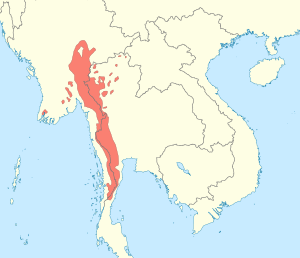Karenic languages facts for kids
Quick facts for kids Karenic |
|
|---|---|
| Ethnicity: | Karen people |
| Geographic distribution: |
South-eastern Myanmar, Western Thailand |
| Linguistic classification: | Sino-Tibetan
|
| Proto-language: | Proto-Karenic |
| Subdivisions: |
Sgaw
Pa'O
Pwo
|
| ISO 639-2 and 639-5: | kar |
 |
|
The Karen (/kəˈrɛn/) or Karenic languages are tonal languages spoken by some 4.5 million Karen people. They are of unclear affiliation within the Sino-Tibetan languages. The Karen languages are written using the Karen script. The three main branches are Sgaw, Pwo and Pa'O. Karenni (also known as Kayah or Red Karen) and Kayan (also known as Padaung) are a branch of Karen languages. They are unusual among the Sino-Tibetan languages in having a subject–verb–object word order; other than Karen, Bai and the Chinese languages, Sino-Tibetan languages have a subject–object–verb order. This is likely due to influence from neighboring Mon and Tai languages.
Classification
Because they differ from other Tibeto-Burman languages in morphology and syntax, Benedict (1972: 2–4, 129) removed the Karen languages from Tibeto-Burman in a Tibeto-Karen branch, but this is no longer accepted.
A common geographical classification distinguishes three groups:
- Northern
- Pa’o
- Central
- The area of greatest diversity, including Kayah (Red Karen or Karenni), Kayaw (Brek), Bwe (Bghai), Geba and many more.
- Southern
- Pwo and Sgaw
Kayan (Padaung) is transitional between the northern and central groups. The languages with the most speakers are Sgaw, Pwo and Pa’o.
Manson (2011)
Manson (2011) classifies the Karen languages as follows, with each primary branch characterized by phonological innovations:
- Karen
- Peripheral: proto-voiceless stop initials appearing as aspirated stops (e.g. *p > pʰ)
- Pa’o
- Pwo
- Northern: merger of nasal finals (e.g. *am, *an > aɴ), merger of stop-final rhymes with the open counterpart (e.g. *aʔ, *a > a)
- Kayan
- Lahta
- Yinbaw
- Yintale
- Central: vowel raising (e.g. *a > ɛ)
- Western Kayah, Eastern Kayah
- Geba, Bwe
- Paku (?)
- Geker, Gekho (?; may be Central or Southern)
- Kayaw, Manu (?; may be Central or Southern)
- Southern: merger of nasal-final rhymes, with the rhyme subsequently raised (e.g. *am, *aŋ > ɔ)
- Sgaw, Paku
- Dermuha, Palaychi
The classifications of Geker, Gekho, Kayaw, and Manu are ambiguous, as they may be either Central or Southern.
Shintani (2012)
Shintani Tadahiko (2012:x) gives the following tentative classification, proposed in 2002, for what he calls the "Brakaloungic" languages, of which Karen is a branch. Individual languages are marked in italics.
- Brakaloungic
- Pao
- Pao
- Karen
- Kayah-Padaung
- Kayah
- Pado-Thaido-Gekho
- Thaidai
- Pado-Gekho
- Gekho
- Padaung
- Padaung (Kayan)
- Gekho (Yathu Gekho)
- Bwe
- Bweba-Kayaw
- Kayaw
- Bweba
- Geba
- Bwe
- Bweba-Kayaw
- Sgaw-Pwo
- Pwo
- Mobwa
- Mopwa
- Blimaw
- Pako-Sgaw
- Sgaw
- Pakubwa
- Paku
- Monebwa
- Thalebwa
- Kayah-Padaung
- Pao
However, at the time of publication, Shintani (2012) reports that there are more than 40 Brakaloungic languages and/or dialects, many of which have only been recently reported and documented. Shintani also reports that Mon influence is present in all Brakaloungic languages, while some also have significant Burmese and Shan influence.
The Kayan languages are spoken in Kayah State, southern Shan State, and northern Karen State. There are four branches according to Shintani (2016), namely Kangan ("lowland dwellers"), Kakhaung ("highland dwellers"), Lawi ("South"), and Latha ("North"). Nangki (sometimes called Langki), documented in Shintani (2016), is one of the Kayan languages belonging to the Kakhaung subgroup. It is spoken only in one village.
Kadaw is spoken in Kayah State, and has nasalized vowels but no final nasal consonants. It has more Burmese than Shan influence. Thamidai is yet another Karenic language.
Below is a classification of the Karenic languages by Hsiu (2019) based on a phylogenetic analysis of Shintani's published lexical data. The results support the overall structure of Shintani's (2012) classification.
- Karenic
- Pa'o
- Northern
- Southern
- Karen
- Kayan (Padaungic)
- Kayin Phyu
- Yathu Gekho
- Thaidai
- Padaung cluster: Padaung, Yinbaw, Kangan ("lowland") Kayan, Kakhaung ("highland") Kayan
- Gekho cluster: Gekho, Kadaw, Taungmying
- Nagi (Nangki) Kayan
- Latha ("North") Kayan, Zayein
- Thamidai
- Kayah (Karenni)
- West Kayah, Manaw
- Yingtalay
- Manu-Bwe
- Manu
- Bwe
- East Kayaw
- West Kayaw
- Bwe
- Geba
- Mopwa-Pwo-Sgaw
- Mopwa, Blimaw
- Pwo-Sgaw
- Pwo
- Sgaw cluster
- Sgaw
- Monebwa, Paku
- Thalebwa
- Kayan (Padaungic)
- Pa'o
Luangthongkum (2019)
Luangthongkum (2019) recognizes three branches of Proto-Karen, namely Northern, Central, and Southern, but is agnostic about how the three branches fit together.
- Karenic
- Northern
- Northern Pa-O
- Southern Pa-O
- Central
- Kayan
- Kayah
- Western Bwe (Blimaw, Geba)
- Kayaw
- Southern
- Northern Sgaw
- Southern Sgaw
- Northern Pwo
- Southern Pwo
Note: Western Bwe Karen (Blimaw, Geba) preserves the implosives or preglottalised obstruents ɓ/ʔb and ɗ/ʔd, as well as voiceless sonorants such as hn, hl, and so forth.
Reconstruction
See also
 In Spanish: Lenguas karénicas para niños
In Spanish: Lenguas karénicas para niños

